| Columns Retired Columns & Blogs |
Any comment on how it performs as a PS4 controller?
I measured the Chord DAVE with my Audio Precision SYS2722 system (see the January 2008 "As We See It"), using both the Audio Precision's optical and electrical digital outputs and USB data sourced from my MacBook Pro running on battery power with Pure Music 3.0 playing WAV and AIFF test-tone files. Apple's USB Prober utility identified the Chord as "Dave" from "Chord Electronics Ltd," with the serial number "413-001." The DAVE's USB port operated in the optimal isochronous asynchronous mode. Apple's AudioMIDI utility revealed that, via USB, the DAVE accepted 32-bit integer data sampled at all rates from 32 to 768kHz. The optical input locked to datastreams with sample rates up to 96kHz, the AES/EBU and S/PDIF inputs locked to streams of up to 192kHz-sampled data.
In variable mode, the Chord's maximum output level at 1kHz with the volume control set to "0dB" was 8.75V from the balanced output jacks, 4.375V from the unbalanced jacks and the headphone jack. With the volume control set to "+3dB," the levels were 12.35V balanced and 6.18V unbalanced, but the DAVE clipped with full-scale data at settings of "+3dB" and above. In Fixed mode, the maximum balanced output level at 1kHz was 6.2V, equivalent to setting the volume control to "–3dB." All three outputs preserved absolute polarity (ie, were non-inverting) with Phase set to Pos. The XLR jacks are wired with pin 2 hot. The output impedance from the unbalanced and headphone jacks was extraordinarily low, at <0.5 ohm. The balanced output impedance was a still-low 66 ohms at all audio frequencies.
Fig.1 shows the DAVE's impulse response with 44.1kHz data. It is typical of a time-symmetrical FIR type, but with many more coefficients than I usually see. This is a long filter. In fact, with the pulse-stream signal I use, the impulse response hasn't finished decaying before the next impulse arrives. Tested with white noise sampled at 44.1kHz (footnote 1), the Chord's output rolled off extraordinarily quickly above 20kHz (fig.2, red and magenta traces). The filter reached full attenuation by the Nyquist frequency, 22.05kHz (fig.2, vertical green line), meaning that the aliased image of a full-scale 19.1kHz tone (blue, cyan) at 25kHz is completely eliminated. Note also how low the distortion harmonics of that tone are.
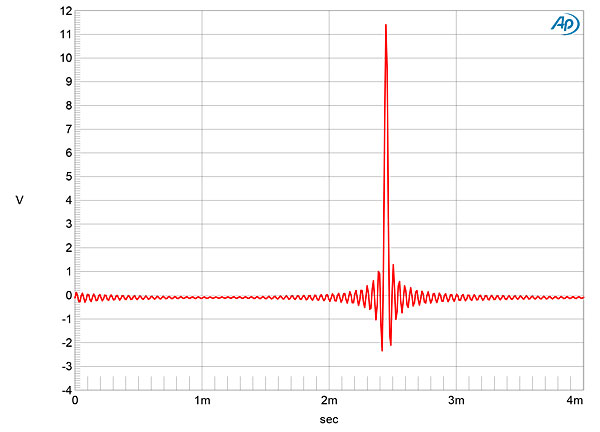
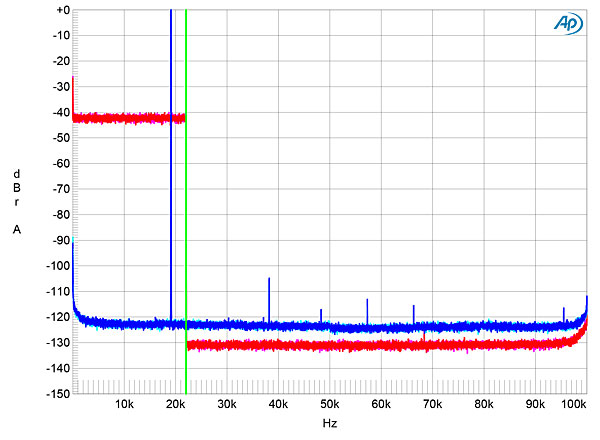
The DAVE's frequency response with data sampled at 44.1, 96, 192, and 384kHz is shown in fig.3. At the three lower rates, the rolloff follows the same basic shape, with a very sharp rolloff just below the Nyquist frequency. Only with 384kHz data (blue and green traces) does the ultrasonic rolloff continue smoothly, reaching –13.3dB at 190kHz. This graph was taken with the HF filter off. With it turned on (not shown), the response was down by 3dB at 40kHz with 96kHz data and by 8dB at 60kHz with 192kHz data. Channel separation was superb, at >125dB in both directions below 1kHz, decreasing to a still-excellent 95dB at the top of the audioband. The low-frequency noise floor (fig.4) was commendably free from any power-supply–related spuriae.

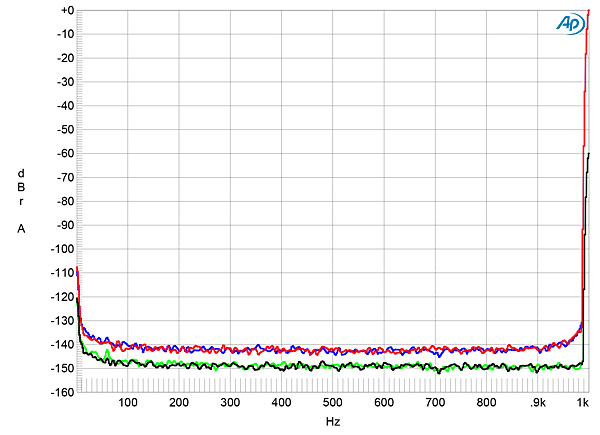
When I changed the bit depth of the incoming data from 16 to 24 with a dithered tone at –90dBFS, the noise floor dropped by 23dB (fig.5), implying resolution close to 20 bits, which is state-of-the-art DAC performance. With 24-bit USB data, the spectrum (fig.6) was completely free from harmonic and suply-related spuriae. However, while the three DC voltage levels of an undithered tone at exactly –90.31dBFS were well defined, the Chord's reproduction of them was obscured by high-frequency random noise (fig.7). This graph was taken with the HF filter off; the waveform became no cleaner with the filter switched on. With undithered 24-bit data, the DAVE output a noisy sinewave (not shown).
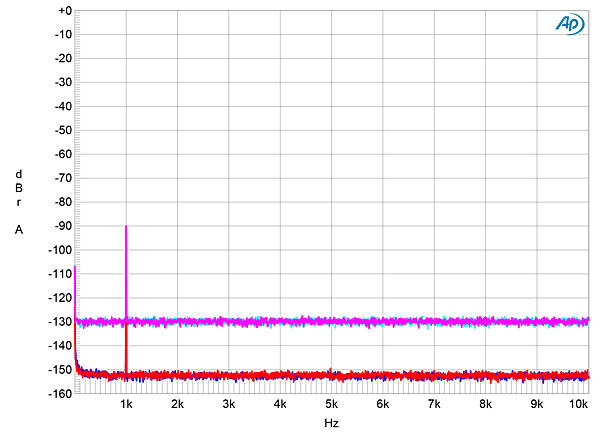
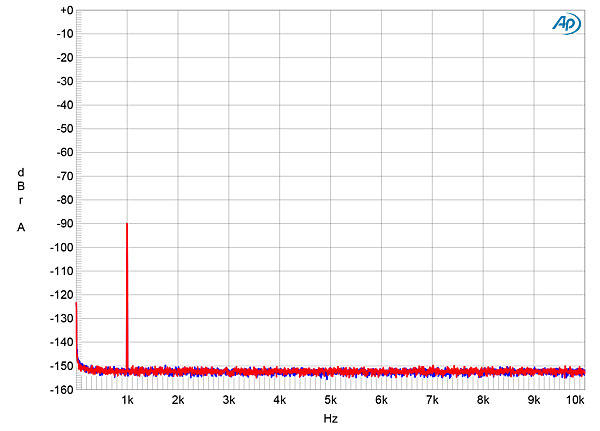
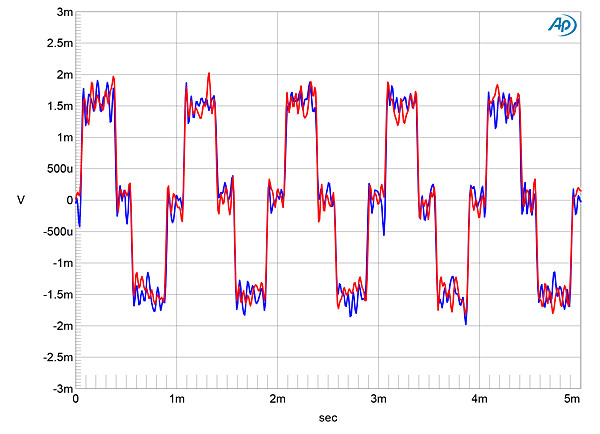
As implied by fig.2, the DAVE had extraordinarily low harmonic distortion, even into the punishing 600 ohm load (fig.8), where the only significant harmonic was the third—if you can call something at –120dB (0.0001%) "significant." Intermodulation distortion was similarly vanishingly low (fig.9). When I tested for word-clock–related jitter rejection with 16-bit TosLink J-Test data (fig.10), all the odd-order harmonics of the LSB-level, low-frequency squarewave were at the correct levels (green line), and no jitter-related sidebands are visible. With 24-bit J-Test data (fig.11), the spectrum is free from any jitter artifacts; all that can be seen is the very low level of random noise.
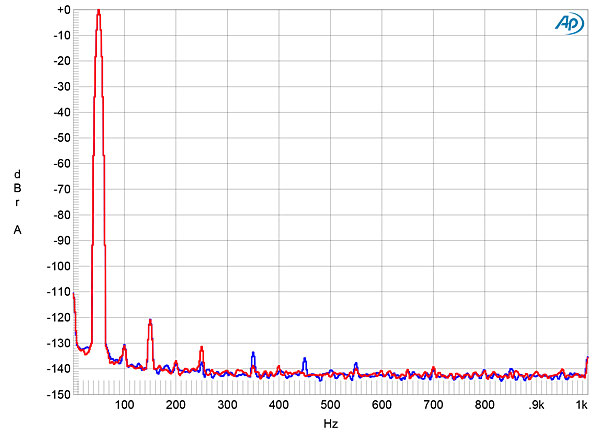
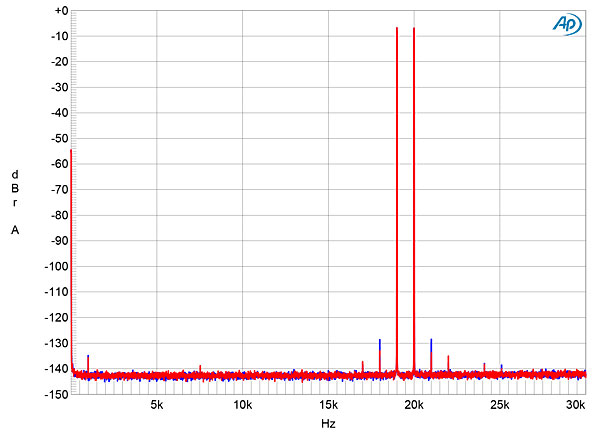
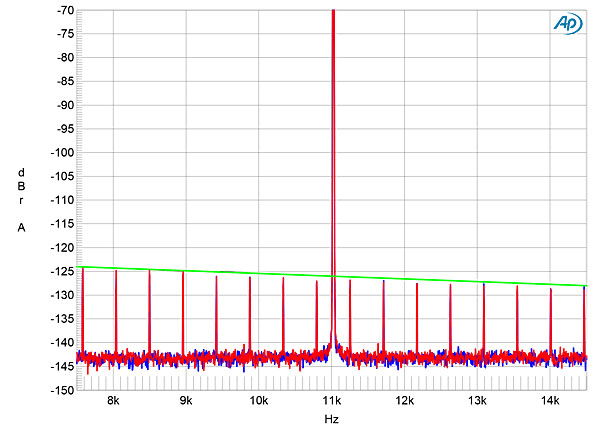
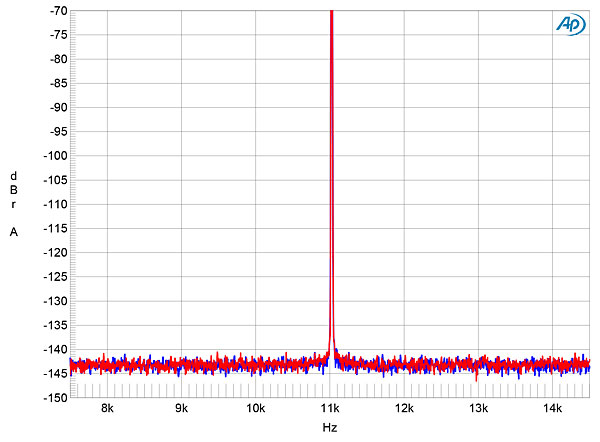
Even if I hadn't auditioned Chord's DAVE, I would have been impressed by this DAC. Its measured performance is beyond reproach.—John Atkinson

What will come of these DAC designs as MQA gains even more Gravity?
Already we have respected folks like Hans Beekhuyzen, JA and Mastering Engineers ( like Bob Ludwig ) explaining the Future Benefits.
Mr. Ludwig says that MQA removes Pre-Ringing, whew, that alone makes it worthwhile, doesn't it?
Perhaps ( reluctantly ) we say 'by-by' to Multi-bit, R2R, FGPA and any another design not adaptable. ( Schiit YGGY obsolete?, certainly! )
It feels like Digital was refined, than more refined, then refined yet again. phew.
There are only a few 'remnant' that still cling to vinyl as their primary music storage system, it just seems so awkward and cumbersome. Why would a new music lover want Vinyl expense and square footage demands?, especially since MQA Dac prices start at $200!
Right now, today, I'm figuring that everyone in the Audio Business wants to be Bob Stuart.
Tony in Michigan

Hey Tony... I trust that was said with tongue firmly superglued to cheek :-).
I'm not sure if most want to be Mr. Stuart. I'm sure the company must have spent a pretty penny on MQA marketing over the years just from the business perspective.

There is a Team of Software Developers behind all this, Stuart is their Managing Director who's flying around the World selling the Project.
It seems like everyone is getting On-Board.
Betcha it's exciting to be a part it.
Right now, everywhere there's an Audio Group gathering, Stuart is their No.1 choice for Keynote Speaker. Sort-of like he's the Steve Jobs of Audio.
Tony in Michigan
ps. this is my estimation, I've always like Meridian designs, I've been one of their dealers.

I use MQA for streaming, it's fine.
I don't get the evangelical response it has received in certain corners. It's like someone told a tale of finding some golden ears in a secret place hidden by an audio angel and created the "Book of MQA" and the cult took off from there.

Wonderful analogy, wish I'd of thought of it.
But
Meridian has always been an Engineering Company ( like 3M Corp. ), they've been at the forefront of Digital advancement. I've know these guys since the early 1980s, they're a no-bullshi... type group.
I don't think that I 'believe' in Meridian or MQA but rather I trust Meridian and MQA. The down-side being that they are upper-middle class. Still, a person can access MQA with a $200 Explorer2, $300 for an Audioquest Dragonfly RED or go full desktop with a Mytek for $2,000. ( we can't and won't be able to get a Schiit Bifrost MQA, too bad, I'm a Schiit fanboy )
I don't expect greatness from MQA, just advancement.
I hope we're not boxing ourselves into another corner.
Tony in Michigan

This ----> "I hope we're not boxing ourselves into another corner."

Ortofon sent their Man to Analog Planet Headquarters to show their New & Improved $4,000 Phono Cartridge, the video is now on YouTube. Please notice the vastness of the Vinyl Record Collection used as the Backdrop, it's gigantic ! Vinyl guys are boxed into storage of Vinyl and the Fragile nature of the Gear needed for playback, not to mention the total lack of portability & incredible expense.
CD is copyable so it's profit possibility for Artists is less ( perhaps considerably less )
MQA/Tidal is Global in nature, as the World adopts Streaming, new issues will manifest themselves. Will this become another limiting factor?
My hope is to have access to all the recorded music that's out there, on a rental basis. I don't want to rely on my own digital storage & hard copy storage systems.
If I dump my vast CD collection and abandon my hard drive storage systems to rely on Tidal's rental collection will I be boxed in and risk Tidal going out of business? ( and ever increasing Monthly usage charges ).
Seems like there's always something to be worried about, like getting the Big C.
Tony in Michigan

Chord's view -- "going for broke" on no. of taps to use in their devices -- is interesting.
Only a few weeks ago, Stereophile had a YouTube video interview with heads of mbl (German company). I think they said tap qty was more of an art and science -- a Goldilocks approach. If you go too high (as far as mbl was concerned) you can start harming the sound.

Any chance Chord Electronics will be so kind as to send you their Blue 2 CD to add to the equation?

This may be an oversight or my lack of understanding. But if you notice, the -90 dBFS 16-bit tone plot has a 1.5 mV peak-to-peak range. This seems unusually high relative to other plots I've seen here.
That seems to imply that 0 dBFS is about 33.5 Vrms or so. Doesn't this DAC clip at 12.35 Vrms? (assuming 8.75V is rms and "+3dB" mode is therefore 12.35 Vrms)
Wouldn't that create the illusion of more effective number of bits because the 0 dBFS signal power is much higher, relative to noise floor, than when referenced to a perhaps more standard 2.0 or 4.0 Vrms? I say illusion because of clipping, and because not many downstream equipment (for example, an amplifier) may accept a 33.5 Vrms range with out any issues.
By similar arguments, wouldn't a 1.5 mV peak-to-peak -90 dBFS plot seem visually less noisy when compared to a say 0.2 mV peak-to-peak -90 dBFS plot?

This may be an oversight or my lack of understanding. But if you notice, the -90 dBFS 16-bit tone plot has a 1.5 mV peak-to-peak range. This seems unusually high relative to other plots I've seen here.
Yes it is. I set the Chord's volume control to its maximum for this test, even though that would have resulted in clipping with a full-scale signal, because I couldn't replicate the manufacturer's own measurement at lower levels.
Wouldn't that create the illusion of more effective number of bits because the 0 dBFS signal power is much higher, relative to noise floor, than when referenced to a perhaps more standard 2.0 or 4.0 Vrms?
With this test I was more concerned with looking at waveform symmetry with the undithered data.
John Atkinson
Editor, Stereophile

I am slightly confused. On the one hand you say:
With this test I was more concerned with looking at waveform symmetry with the undithered data.
i.e., the fact that I boosted the volume to impracticable levels is not relevant to the test results. On the other hand you say:
I set the Chord's volume control to its maximum for this test, even though that would have resulted in clipping with a full-scale signal, because I couldn't replicate the manufacturer's own measurement at lower levels.
i.e., the fact that I boosted the volume to impracticable levels is critical to the test results, as it is only by so doing that I can avoid the conclusion that the manufacturer's claims are spurious. I am reminded of a well known expression involving the eating of cake.
Could I suggest that you provide the results at a standardised level that does not clip the full scale output, so as to allow a fair comparison with other products you have objectively tested?

For the yggydrasil review, you measured similar test waveform of undithered 1kHz sinewave...
yet at 24-bit data, and at extremely small levels of 200uV peak to peak!.
Then with Dave you change your test parameters because you cant get a good "manufacturer" result???!
This leads to pics that are thus misleading for the Dave, in comparison to all other Dacs reviews.
I rather to see a uniformity in your testing to be able to get a true comparison to other dacs, especially the yggydrasil.
As it stands member "ultrabike" sheds light to this discrepancy in measuring uniformity.
Therefore I would like to know, if you cannot achieve the performance the manufacturer states for the Dave,
What were your initial findings before you decided to "juiced up" the settings?
I already heard the Dave personally and have commented positive about it, so not knocking it, but, in fairness..
Curious members want to know.

I've read all the reviews of the new Chord DACs, and for some reason I feel the team at stereophile doesn't bring up the key reason of the TAPs and the USP of Chord. These DACS all have the fluidity and gentleness of true analog, but this is never mentioned. If you check the review of even the QBD76 on what hi-fi they did identify this very desirable quality. When I play Metallica on Vinyl, and then hear them on my Chord Dave and Chord Mojo, well these do play them with all the energy, and tunefulness (without sounding Harsh) of the Vinyl. Have a lot of respect for JA and the team at stereophile, but would be nice to get Dave reviewed by Fremer and see if it passes his "analog ears" test. (I'm pretty confident he will be pleased)